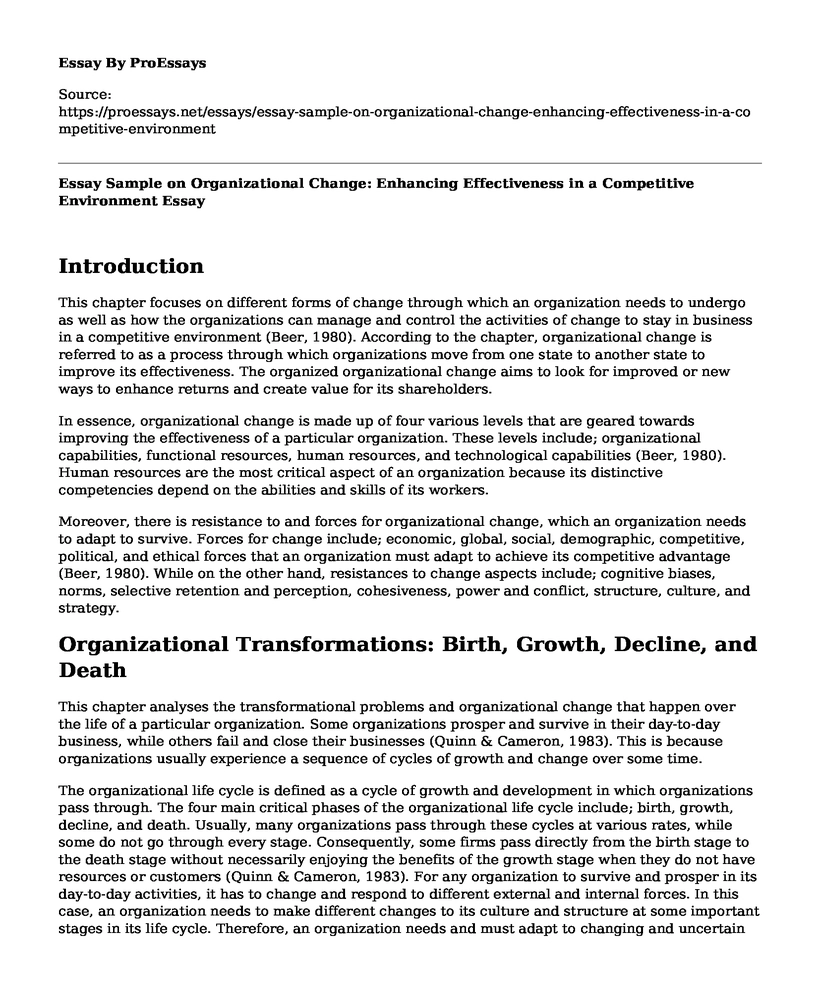Introduction
This chapter focuses on different forms of change through which an organization needs to undergo as well as how the organizations can manage and control the activities of change to stay in business in a competitive environment (Beer, 1980). According to the chapter, organizational change is referred to as a process through which organizations move from one state to another state to improve its effectiveness. The organized organizational change aims to look for improved or new ways to enhance returns and create value for its shareholders.
In essence, organizational change is made up of four various levels that are geared towards improving the effectiveness of a particular organization. These levels include; organizational capabilities, functional resources, human resources, and technological capabilities (Beer, 1980). Human resources are the most critical aspect of an organization because its distinctive competencies depend on the abilities and skills of its workers.
Moreover, there is resistance to and forces for organizational change, which an organization needs to adapt to survive. Forces for change include; economic, global, social, demographic, competitive, political, and ethical forces that an organization must adapt to achieve its competitive advantage (Beer, 1980). While on the other hand, resistances to change aspects include; cognitive biases, norms, selective retention and perception, cohesiveness, power and conflict, structure, culture, and strategy.
Organizational Transformations: Birth, Growth, Decline, and Death
This chapter analyses the transformational problems and organizational change that happen over the life of a particular organization. Some organizations prosper and survive in their day-to-day business, while others fail and close their businesses (Quinn & Cameron, 1983). This is because organizations usually experience a sequence of cycles of growth and change over some time.
The organizational life cycle is defined as a cycle of growth and development in which organizations pass through. The four main critical phases of the organizational life cycle include; birth, growth, decline, and death. Usually, many organizations pass through these cycles at various rates, while some do not go through every stage. Consequently, some firms pass directly from the birth stage to the death stage without necessarily enjoying the benefits of the growth stage when they do not have resources or customers (Quinn & Cameron, 1983). For any organization to survive and prosper in its day-to-day activities, it has to change and respond to different external and internal forces. In this case, an organization needs to make different changes to its culture and structure at some important stages in its life cycle. Therefore, an organization needs and must adapt to changing and uncertain environmental conditions to overcome organizational change that usually threatens its capability to conform to environmental changes.
Decision Making, Learning, Knowledge Management, and Information Technology
This chapter discusses decision-making learning results and choices that ascertain the way a company operates its activities as well as how it transforms or changes itself over some time. According to this chapter, it suggests that organizations need to continually enhance the way different decisions are made so that employees and managers, as well as other stakeholders, can learn new and innovative ways to help them function in an organization and to respond to changing environmental conditions (March, 1981). Through organizational decision making, managers and employees must respond to an emerging problem by looking for and selecting a way or a solution or alternative course of action that will give value to an organization.
Nevertheless, organizational decision making is made up of two types, namely; programmed and non-programmed decision making. Programmed decision making implies selecting the most appropriate, effective, routine, repetitive, and easy set of procedures to solve an organization's problems or activities (March, 1981). On the other hand, non-programmed decision making requires managers and other stakeholders to make the most unstructured, creative, and novel decisions which allow the organization to look for course of actions to uncertain and changing conditions.
Likewise, this chapter discusses two critical models of organizational decision making in which managers use to make decisions that allow their organizations to perfectly adapt to changing environmental conditions in which they operate (March, 1981). These include the Rational Model and The Carnegie Model. Rational Model is a straightforward model of decision making that involves three stages; identification and definition of the problem in question, generating alternative solutions and selecting the best alternative solution to the problem. The Carnegie Model acknowledges the impacts of organizational coalitions, satisficing, and bounded rationality.
References
J.G. March, "Decision Making Perspective," in A. Van De Venn and W. Joyce, eds., Perspectives on Organizational Design and Behaviour (New York: Wiley, 1981), pp. 205-252.
M. Beer, Organizational Change and Development (Santa Monica, CA: Goodyear, 1980); J.I. Porras and R.C. Silvers, "Organization Development and Transformation," Annual Review of Psychology 42 (1992), 51-78
R.E. Quinn and K. Cameron, "Organizational Life Cycles and Shifting Criteria of Effectiveness: Some Preliminary Evidence," Management Science 29 (1983), 33-51.
Cite this page
Essay Sample on Organizational Change: Enhancing Effectiveness in a Competitive Environment. (2023, Mar 26). Retrieved from https://proessays.net/essays/essay-sample-on-organizational-change-enhancing-effectiveness-in-a-competitive-environment
If you are the original author of this essay and no longer wish to have it published on the ProEssays website, please click below to request its removal:
- Avon Products, Inc. Case Study
- Intelligence Community Organization and Careers Essay
- Dunkin Donut Company's Marketing Paper Example
- Analyzing the Internal Organization Paper Example
- Paper Example With Questions on Organizational Theories
- Essay on Organizational Change: Navigating Volatile Political and Global Environments
- Paper Sample on Amazon: From Online Bookseller to Global Retail Giant







